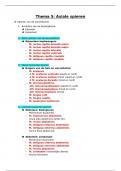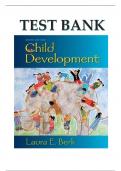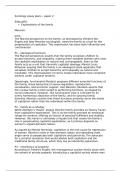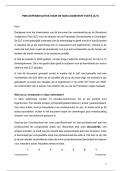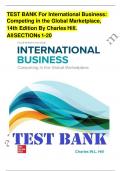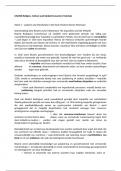Emerging Economies and Global Labour samenvatting alles
Seminars
Week 1
Since the second wave of globalization started, production fell apart. There are hardly any
factories anymore where raw materials go in and final products come out. The value chain is
cut apart and spread over the globe. is this a new phenomenon or did it happen before?
- Heckscher-Ohlin Theory and its consequences
- Global Value Chains
- Disintegration of Production
Economische ontwikkeling: opkomst en neergang
Handelsstromen
Structuur economie en productieketens
Sociale mobiliteit
Economische ongelijkheid
Politieke consequenties
Bedrijfsactiviteiten die heel veel kapitaal en kennis nodig hebben, zullen zich eerder in
Europa vestigen: kapitaal is daar namelijk in overvloed aanwezig en dus goedkoop. Andersom
gezien zullen bedrijven die veel arbeid nodig hebben zich eerder in lagelonenlanden vestigen,
omdat daar juist de arbeid in overvloed aanwezig is en dus goedkoop is.
Globalization, what it brought. Heckscher-Ohlin and other theories of World Trade
Definiëren en uitleggen wat Global Value Chains en hoe ze werken
Uitleggen wat Disintegrated Production is en wat de gevolgen ervan zijn
Uitleggen van de werking van de Heckscher-Ohlintheorie en de implicaties voor
sociaaleconomische beleidsvoorkeuren
Hekscher-Ohlintheorie and Individual Attitudes towards Globalization
Hypothese 1: hoogopgeleid zijn in landen met een hoog bbp per capita heeft een negatief
effect op het protectionistisch sentiment. Positief effect in landen met een laag bbp per capita.
Waarom is het logisch dat het hoog opgeleiden zijn in rijke landen die voor globalisatie
openstaan? En waarom staan laagopgeleiden juist meer voor een protectionistisch beleid zijn?
Omdat hoogopgeleiden meer van de globalisatie profiteren
,Als je allerlei protectionistische maatregelen hebt, kan dat een goede boost zijn voor de lokale
industrie
In rijke landen is er eigenlijk niet zoveel arbeid, maar vooral veel kapitaal. Dat betekent dus
dat arbeid relatief duur is. Wat gebeurt er als je de grenzen opent? Bedrijven trekken weg naar
landen als China en mensen die afhankelijk zijn van productieactiviteiten (banen waar je niet
hoogopgeleid voor hoeft te zijn), die zijn de klos.
Dus: laagopgeleid open voor protectionisme en hoogopgeleid staat daar negatiever tegenover
Hypothese 2: hoogopgeleid zijn in landen met een hoog bbp per capita heeft een negatief
effect op anti-immigratie sentiment. Positief effect in landen met een laag bbp per capita
Als je mensen vrij laat reizen over de hele wereld krijg je een influx van arbeid elders in de
wereld naar jou, en dan heb je nog steeds te maken met concurrentie
De productie vindt dan plaats in Nederland maar wel door dezelfde Chinese mensen die de
wereld hebben overgestoken
Je hebt dus eigenlijk dezelfde situatie maar dezelfde hypothese, niet voor protectionisme maar
voor anti-immigratie
Zijn conclusie is eigenlijk: hypothese 1,3 en 4 worden behoorlijk goed bevestigd. Hypothese 2
minder, daar zijn ook correcties op. Een redelijk groot gedeelte van zijn hypothese komt
eigenlijk overeen, waarin je dus zou kunnen concluderen dat zijn theorie goed overeenkomt
omdat wanneer mensen rationeel nadenken ze ook tot deze conclusies kunnen komen. Hieruit
blijkt dus dat hoogopgeleiden in rijke landen positief staan tegenover globalisatie &
laagopgeleiden in rijke landen negatief. Armen in arme landen staan daarentegen juist positief
tegenover globalisatie en rijken in arme landen staan negatief tegenover globalisatie?
,Lecture 1
Globalization, what it brought. Heckscher-Ohlin and other Theories on World Trade
Most spectacular development visualized in the graph
For the first time, the majority of the world population is no longer extremely poor
Only Africa is lagging behind, but a positive development is also underway there
That is a great improvement!
Has enormous economic, social, and political implications
Some consequences are problematic, but nonetheless great.
Paul Krugman 1995
Wrote a huge article: ‘Growing World Trade: Causes and Consequences’
Super trading economies: countries whose 1990 exports exceeded 50% of GDP
o Singapore, Hong Kong, Malaysia, Belgium, Ireland, the Netherlands
Theoretically impossible since the non-tradable sector always is over 60% of GDP
o Possible because GDP is the total added value in a country during a year
o Trade is the absolute value of the exported goods and services
Exports can be much higher than 50% of the GDP when a substantial part of its value
is imported
Consequently: the value added in the exporting country is only a part of the export
value
Krugman thought it a new phenomenon
Caused by cutting up production chains
, o Nowadays: International Value Chains
o Causes: for every step in the production chain again a decision is made as to
where it will be produced
Super-trading economies
Term never used anymore, but nowadays many more countries in that category
National economy is, apart from the non-tradable sectors, nothing but a series of
mutually unrelated links in international value chains
o A country does not so much produce this or that
o A country has some functions in international productions chains
Production more and more internationalized
The question is why?
Not completely new
Since 1863, the Netherlands already had an export of over 60% of its GDP!
Reason exactly the same
The Dutch supplied the emerging German industry just across the border with
imported, slightly improved raw materials
Limited added value in the Netherlands
Export enormous
Transport costs low: rhine barging
Why did trade increase so much?
Essential: much lower transport costs
Jan Tinbergen: gravity model of international trade
Tij = A (YixYj / Dij)
o Predict bilateral trade between two countries
o Indicators: GDP and distance
o I and J: countries
o T: trade flow
o A: given constant
o Y: size of the economy (GDP) of each country (multiplied)
o D: the distance between the countries
The multiplication of the national incomes is divided by distance
Distance, has a decreasing effect on trade, the formula says
In fact, not distance but trading cost do
Seminars
Week 1
Since the second wave of globalization started, production fell apart. There are hardly any
factories anymore where raw materials go in and final products come out. The value chain is
cut apart and spread over the globe. is this a new phenomenon or did it happen before?
- Heckscher-Ohlin Theory and its consequences
- Global Value Chains
- Disintegration of Production
Economische ontwikkeling: opkomst en neergang
Handelsstromen
Structuur economie en productieketens
Sociale mobiliteit
Economische ongelijkheid
Politieke consequenties
Bedrijfsactiviteiten die heel veel kapitaal en kennis nodig hebben, zullen zich eerder in
Europa vestigen: kapitaal is daar namelijk in overvloed aanwezig en dus goedkoop. Andersom
gezien zullen bedrijven die veel arbeid nodig hebben zich eerder in lagelonenlanden vestigen,
omdat daar juist de arbeid in overvloed aanwezig is en dus goedkoop is.
Globalization, what it brought. Heckscher-Ohlin and other theories of World Trade
Definiëren en uitleggen wat Global Value Chains en hoe ze werken
Uitleggen wat Disintegrated Production is en wat de gevolgen ervan zijn
Uitleggen van de werking van de Heckscher-Ohlintheorie en de implicaties voor
sociaaleconomische beleidsvoorkeuren
Hekscher-Ohlintheorie and Individual Attitudes towards Globalization
Hypothese 1: hoogopgeleid zijn in landen met een hoog bbp per capita heeft een negatief
effect op het protectionistisch sentiment. Positief effect in landen met een laag bbp per capita.
Waarom is het logisch dat het hoog opgeleiden zijn in rijke landen die voor globalisatie
openstaan? En waarom staan laagopgeleiden juist meer voor een protectionistisch beleid zijn?
Omdat hoogopgeleiden meer van de globalisatie profiteren
,Als je allerlei protectionistische maatregelen hebt, kan dat een goede boost zijn voor de lokale
industrie
In rijke landen is er eigenlijk niet zoveel arbeid, maar vooral veel kapitaal. Dat betekent dus
dat arbeid relatief duur is. Wat gebeurt er als je de grenzen opent? Bedrijven trekken weg naar
landen als China en mensen die afhankelijk zijn van productieactiviteiten (banen waar je niet
hoogopgeleid voor hoeft te zijn), die zijn de klos.
Dus: laagopgeleid open voor protectionisme en hoogopgeleid staat daar negatiever tegenover
Hypothese 2: hoogopgeleid zijn in landen met een hoog bbp per capita heeft een negatief
effect op anti-immigratie sentiment. Positief effect in landen met een laag bbp per capita
Als je mensen vrij laat reizen over de hele wereld krijg je een influx van arbeid elders in de
wereld naar jou, en dan heb je nog steeds te maken met concurrentie
De productie vindt dan plaats in Nederland maar wel door dezelfde Chinese mensen die de
wereld hebben overgestoken
Je hebt dus eigenlijk dezelfde situatie maar dezelfde hypothese, niet voor protectionisme maar
voor anti-immigratie
Zijn conclusie is eigenlijk: hypothese 1,3 en 4 worden behoorlijk goed bevestigd. Hypothese 2
minder, daar zijn ook correcties op. Een redelijk groot gedeelte van zijn hypothese komt
eigenlijk overeen, waarin je dus zou kunnen concluderen dat zijn theorie goed overeenkomt
omdat wanneer mensen rationeel nadenken ze ook tot deze conclusies kunnen komen. Hieruit
blijkt dus dat hoogopgeleiden in rijke landen positief staan tegenover globalisatie &
laagopgeleiden in rijke landen negatief. Armen in arme landen staan daarentegen juist positief
tegenover globalisatie en rijken in arme landen staan negatief tegenover globalisatie?
,Lecture 1
Globalization, what it brought. Heckscher-Ohlin and other Theories on World Trade
Most spectacular development visualized in the graph
For the first time, the majority of the world population is no longer extremely poor
Only Africa is lagging behind, but a positive development is also underway there
That is a great improvement!
Has enormous economic, social, and political implications
Some consequences are problematic, but nonetheless great.
Paul Krugman 1995
Wrote a huge article: ‘Growing World Trade: Causes and Consequences’
Super trading economies: countries whose 1990 exports exceeded 50% of GDP
o Singapore, Hong Kong, Malaysia, Belgium, Ireland, the Netherlands
Theoretically impossible since the non-tradable sector always is over 60% of GDP
o Possible because GDP is the total added value in a country during a year
o Trade is the absolute value of the exported goods and services
Exports can be much higher than 50% of the GDP when a substantial part of its value
is imported
Consequently: the value added in the exporting country is only a part of the export
value
Krugman thought it a new phenomenon
Caused by cutting up production chains
, o Nowadays: International Value Chains
o Causes: for every step in the production chain again a decision is made as to
where it will be produced
Super-trading economies
Term never used anymore, but nowadays many more countries in that category
National economy is, apart from the non-tradable sectors, nothing but a series of
mutually unrelated links in international value chains
o A country does not so much produce this or that
o A country has some functions in international productions chains
Production more and more internationalized
The question is why?
Not completely new
Since 1863, the Netherlands already had an export of over 60% of its GDP!
Reason exactly the same
The Dutch supplied the emerging German industry just across the border with
imported, slightly improved raw materials
Limited added value in the Netherlands
Export enormous
Transport costs low: rhine barging
Why did trade increase so much?
Essential: much lower transport costs
Jan Tinbergen: gravity model of international trade
Tij = A (YixYj / Dij)
o Predict bilateral trade between two countries
o Indicators: GDP and distance
o I and J: countries
o T: trade flow
o A: given constant
o Y: size of the economy (GDP) of each country (multiplied)
o D: the distance between the countries
The multiplication of the national incomes is divided by distance
Distance, has a decreasing effect on trade, the formula says
In fact, not distance but trading cost do

